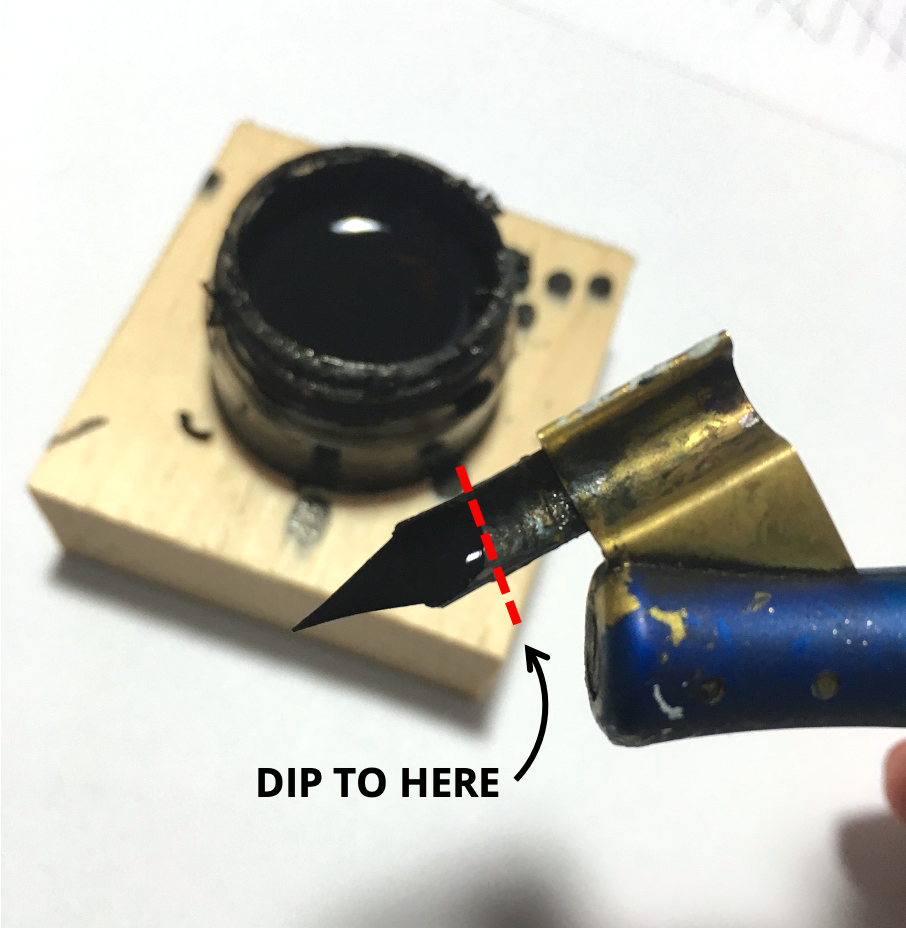Solving Common Pointed Pen Ink Issues
INK: so satisfying to watch…
....but it can also be really frustrating to use!
You're not alone if you've struggled with ink blobs, ink flow, and other common issues with pointed pen calligraphy. This guide will give you methods to help you troubleshoot.
Let's start with the very basics of what you need to know before writing with a pointed pen nib.
Pin it for later! ↓
Table of Contents
How to Prep a Nib
If you notice that your ink is pooling up on your brand-new nib, or not "sticking" to it properly, that's because a nib needs to be prepped first before using.
A brand new nib has a protective coating on it from the manufacturer so it doesn't rust in storage. The coating is not visible, but it needs to be removed first. There are a few ways of doing this and different calligraphers swear by different methods.
I usually start by spraying some Windex on the nib and wiping it with a paper towel, then rinse the nib in water and dry it again. After that, I dip the nib back into my ink and make sure the ink is adhering to the surface.
Another method is to scrub with either toothpaste or dish soap, then rinse. Or if you have a spare potato handy, you can also poke the nib into the potato carefully and let it sit for 10-15 minutes, then rinse. Avoid touching the nib with your fingers as the oils will cause the ink to pool up.
You may also like: How To Choose The Best Calligraphy Nibs [Guide]
How to Dip a Nib
Dip the nib into the ink container so that ink covers the vent hole, but does not reach the flange (the part that holds the nib).
If this “railroad tracks” effect appears immediately, the nib needs to be dipped further. But if the effect appears frequently as you are writing, you'll have to dip your pen more often.
If you’ve been struggling with pointed pen calligraphy because you can’t get the ink to flow smoothly, the next thing to check is the ink consistency.
Ink Consistency
You may not realize that you can adjust the consistency of your ink simply by adding distilled water.
Black Sumi ink is my go-to for practicing. In a small container, I add enough ink to fill it about two-thirds of the way up, then use an eyedropper to fill it almost to the top with water. This creates a ratio of approximately 2 parts ink to 1 part water.If your ink is too thick, it won't flow easily and it'll create blobs when you write. You might see a giant blob when you first press down to create a thick stroke. This could also be caused by too much ink on your nib. Try adding more water to the ink and let some drip off after dipping before you write.
However, adding too much water will make the ink too thin, which can cause other problems. If your ink is thin and your paper is absorbent, the ink will bleed into the paper. Thinner inks work well on less-absorbent paper, where it can sit on top of the surface rather than spreading into it. Be careful not to smudge it since it'll take longer to dry!
If your ink becomes too thin, there are two things you can do. First, add more ink to the container if there is room. Second, if the container is already full, you can leave it open for a few hours so the excess water can evaporate. Be cautious that you don't leave it open too long or forget that it's open - you don't want to spill it or accidentally let it dry out completely (yes, I've experienced both!).
As you're practicing, you'll have to continue adding more ink and/or water to the container. Experiment with the consistency and see what works best with your ink, nib, and paper combination. View our Pointed Pen Supply Guide here.
Specific Ink Types
Some inks like Dr. Ph. Martin's Copperplate Gold are thicker than regular ink, and you won't want to dilute them with water because the color won’t look the same as intended.
For example, if you dilute Bleedproof White ink too much, it will no longer be an opaque white color and instead look transparent. I find that more flexible nibs work better with thicker inks, such as the Hunt 101 nib.
Other inks are meant to be thinner, such as Walnut Ink. If you use Walnut Ink crystals, you'll have to mix them with water until the desired shade is achieved, ranging from dark brown to a beautiful sepia tone.
No matter which ink you choose, make sure to use a high-quality paper.
You may like: Best Calligraphy Paper (Comparisons And Recommendations)
Further Troubleshooting
Troubleshooting is a very important skill to develop when you're learning how to use pointed pen and ink. You have to pay attention to all the different variables (ink type, paper texture, pen angle, nib flexibility, etc.) in order to be comfortable and confident with your supplies. This does take a lot of time, practice, and patience!
Our online course, Calligraphy On Point, has an entire module about the best supplies for beginners, how to use them, and how to troubleshoot. It shows even more problems you may experience and how to solve them so that you're not frustrated!
The course also teaches how to gain control of your pointed pen, execute the fundamental strokes and consistency drills, and build the miniscule & majuscule alphabets in the Copperplate Style. We've also included some bonus lessons including letter variations and flourishing!
Sound like something you might be interested in? Learn more here.
Download Your free Copperplate Guide Sheet:








